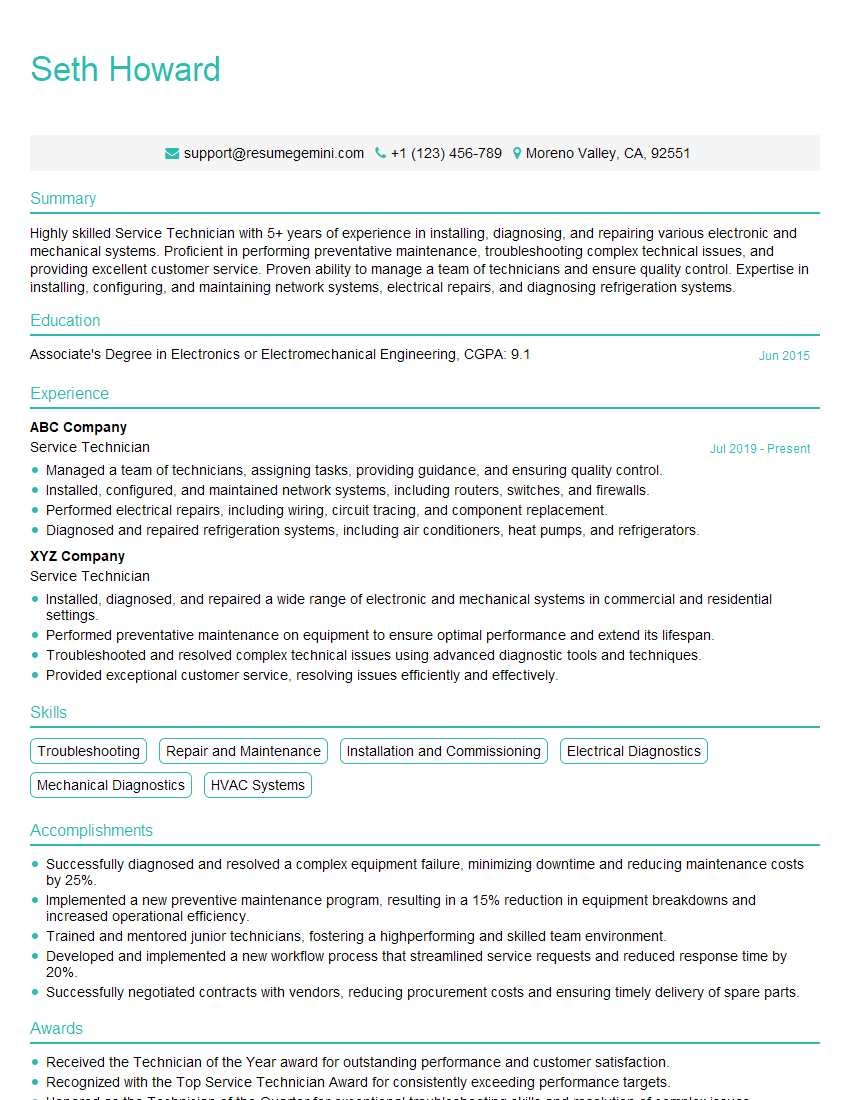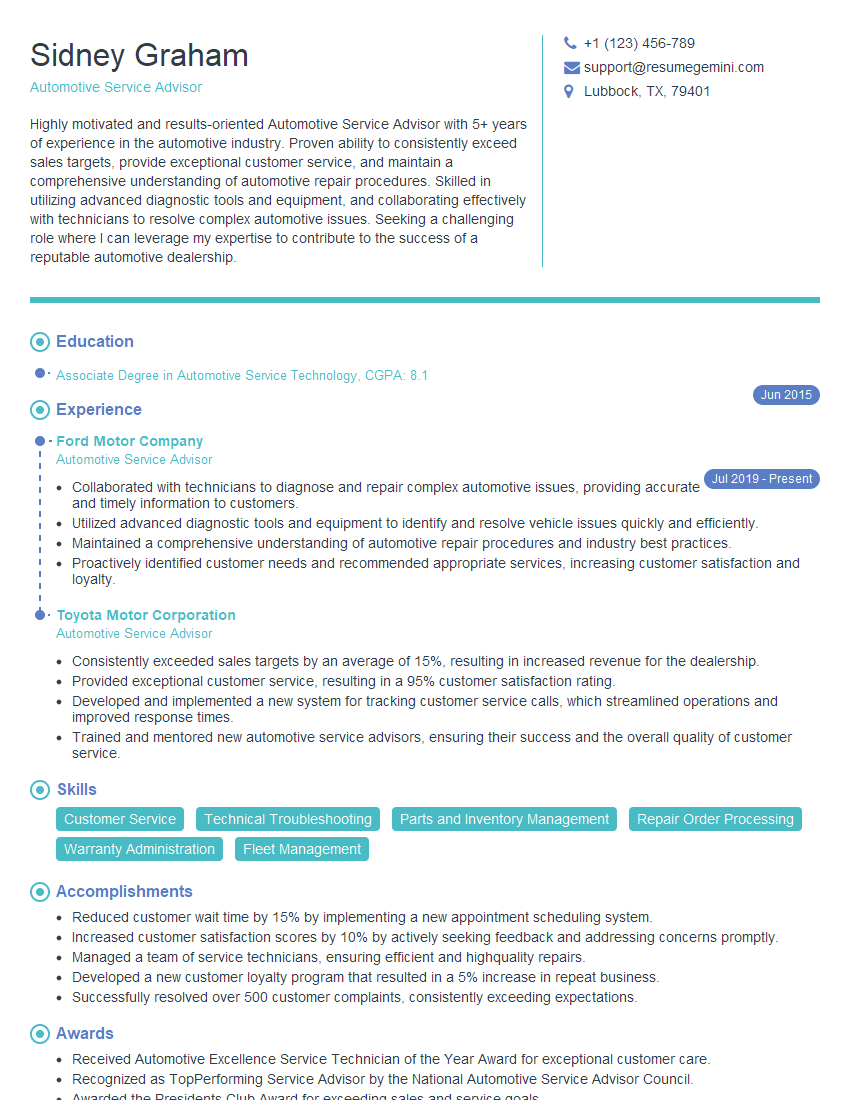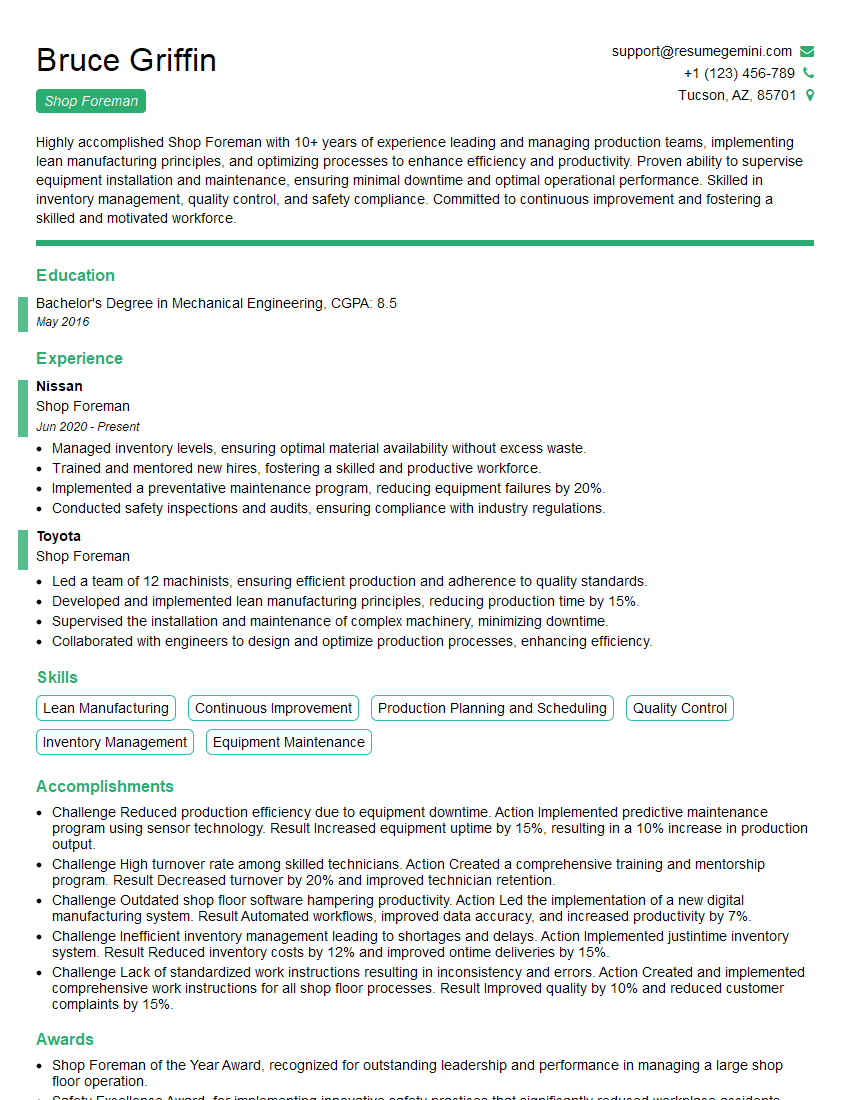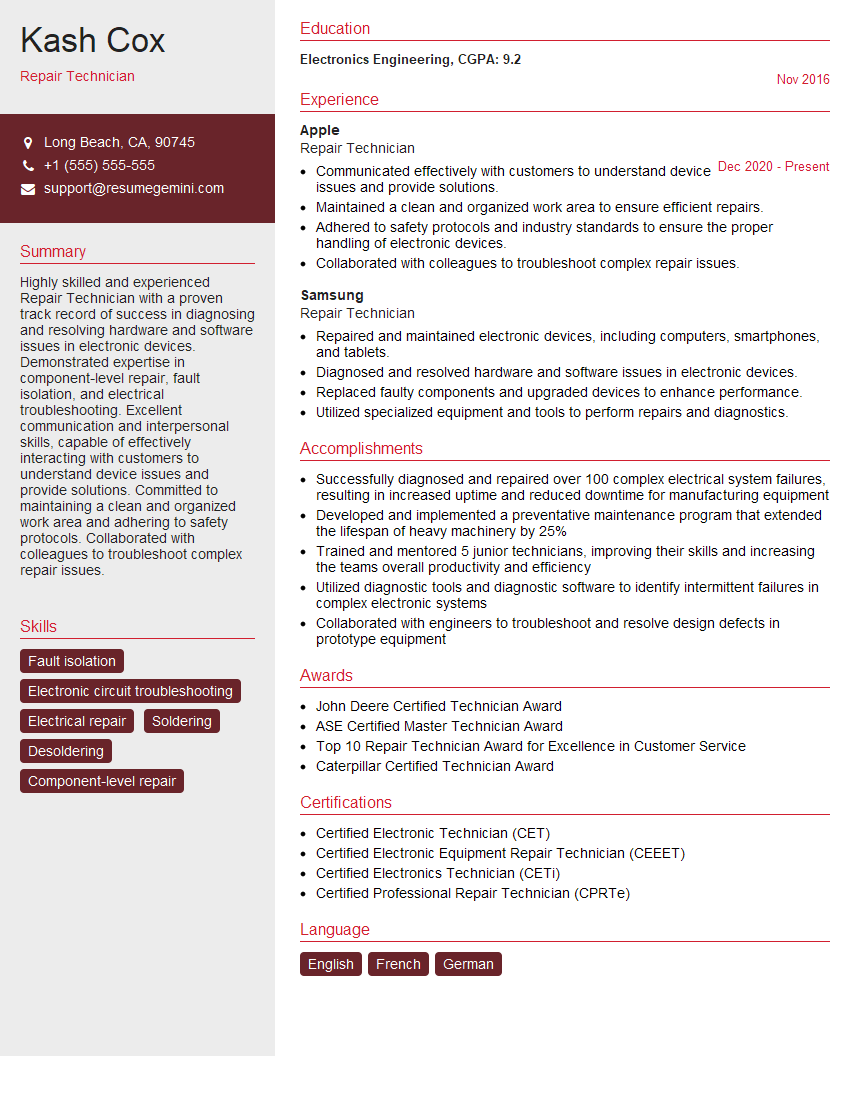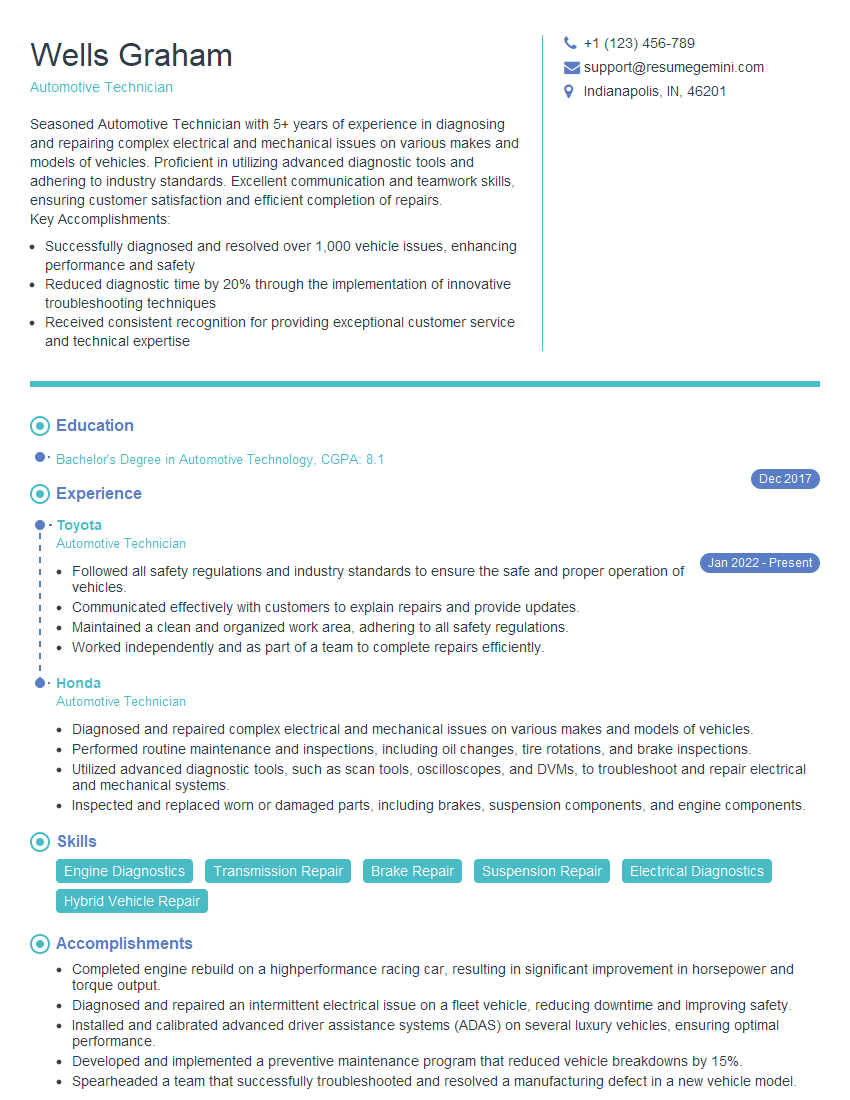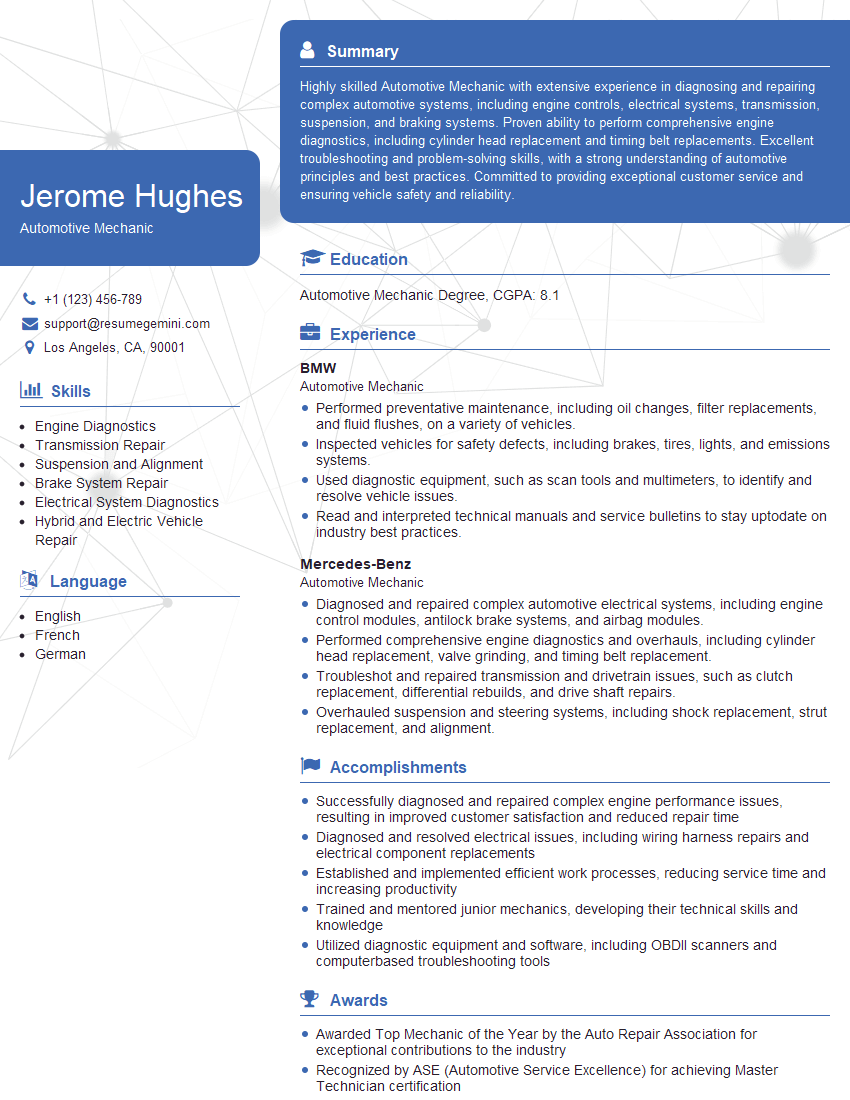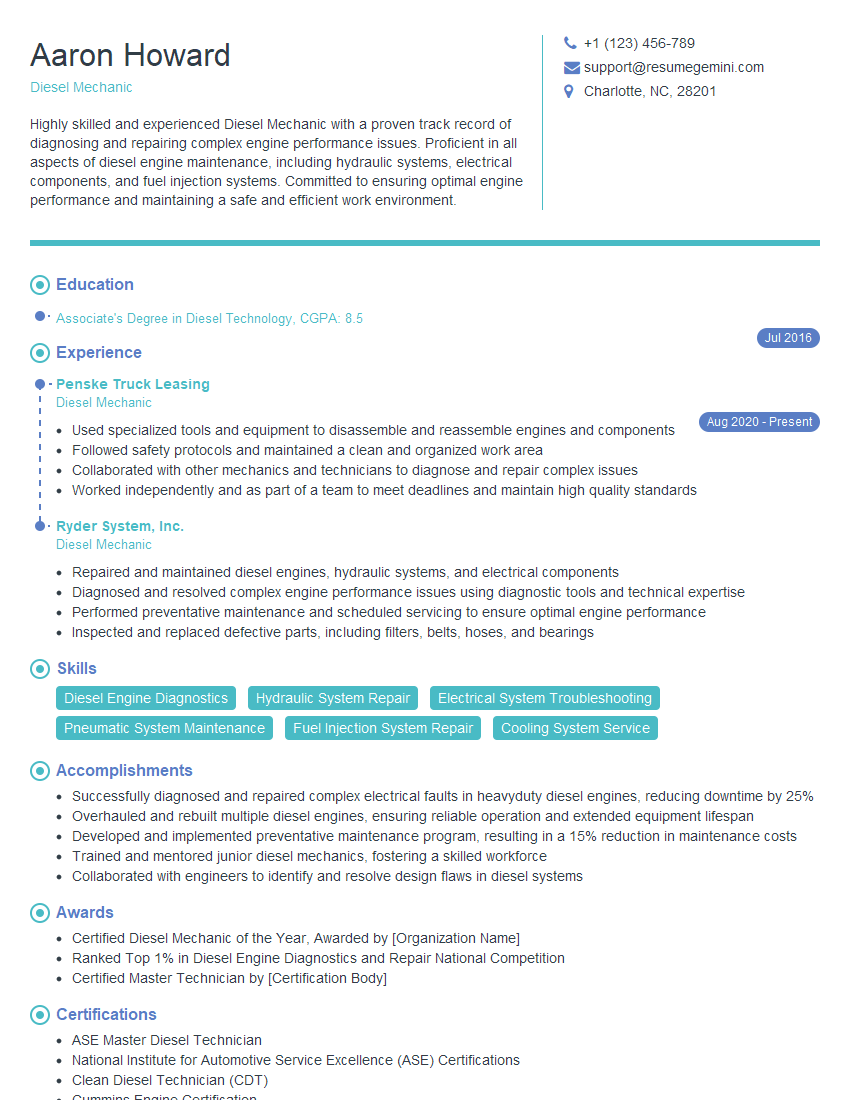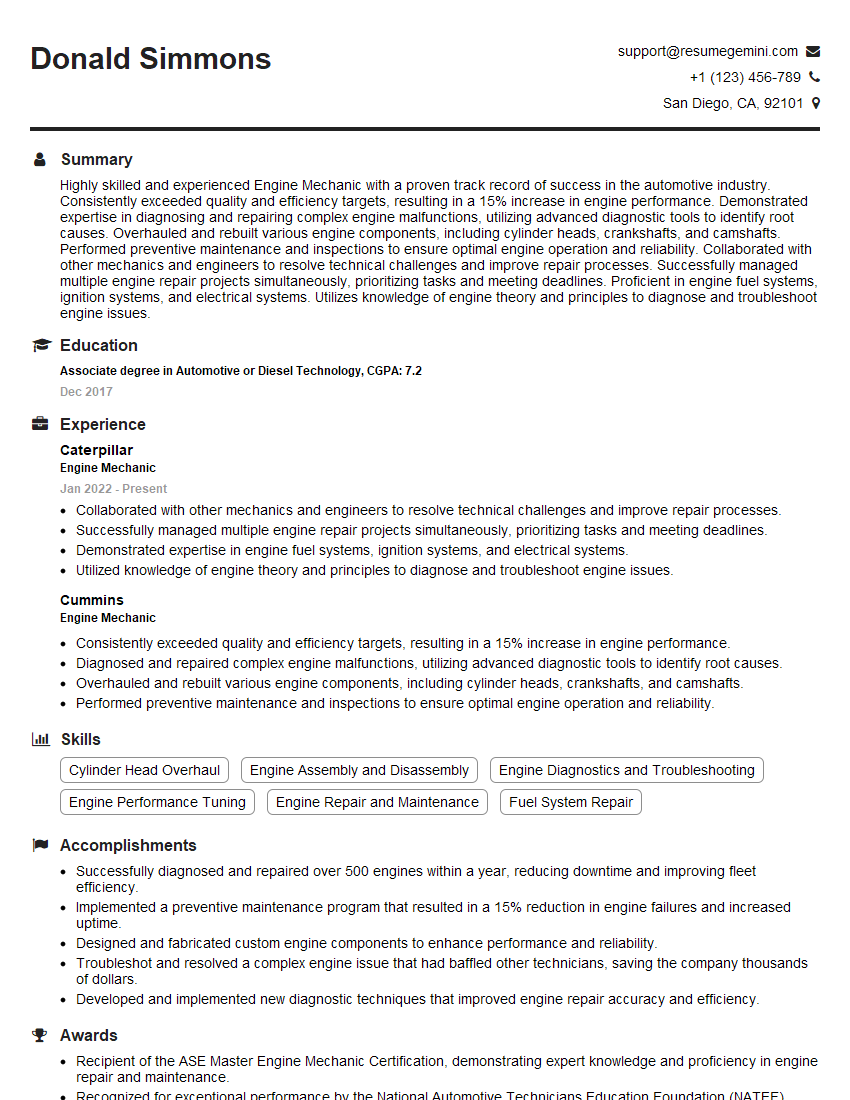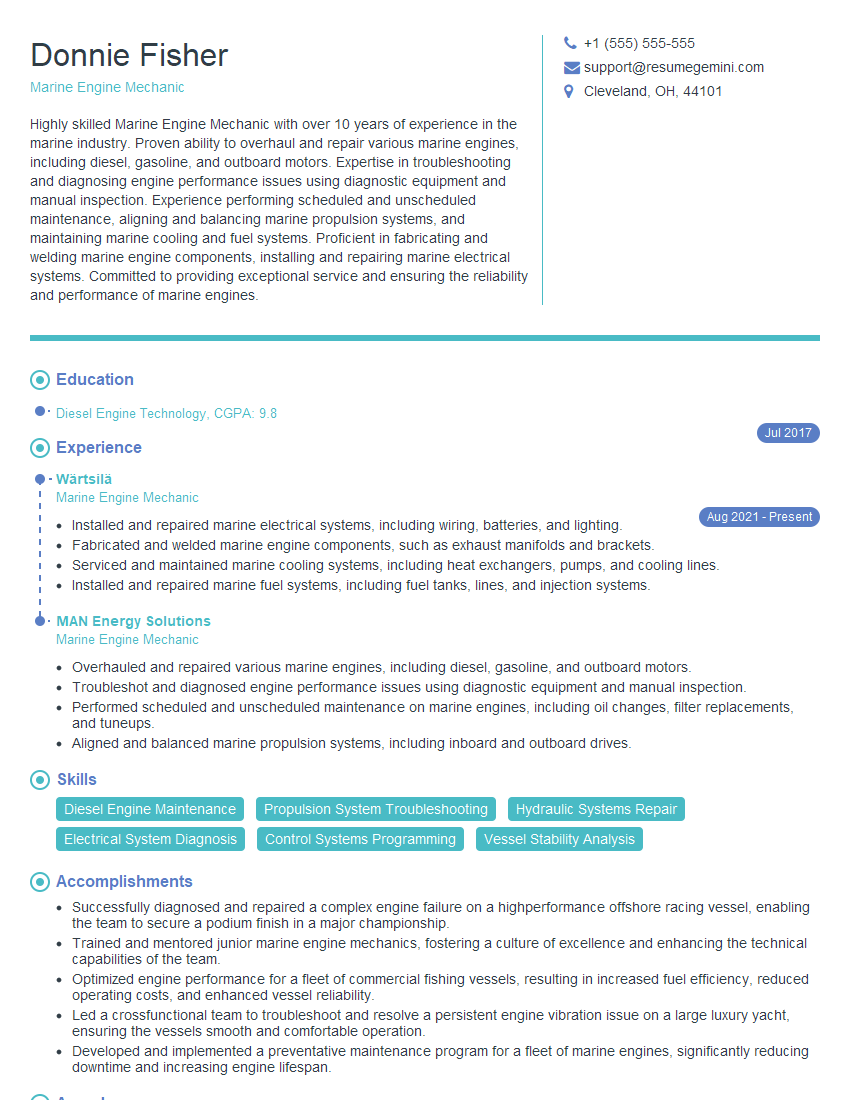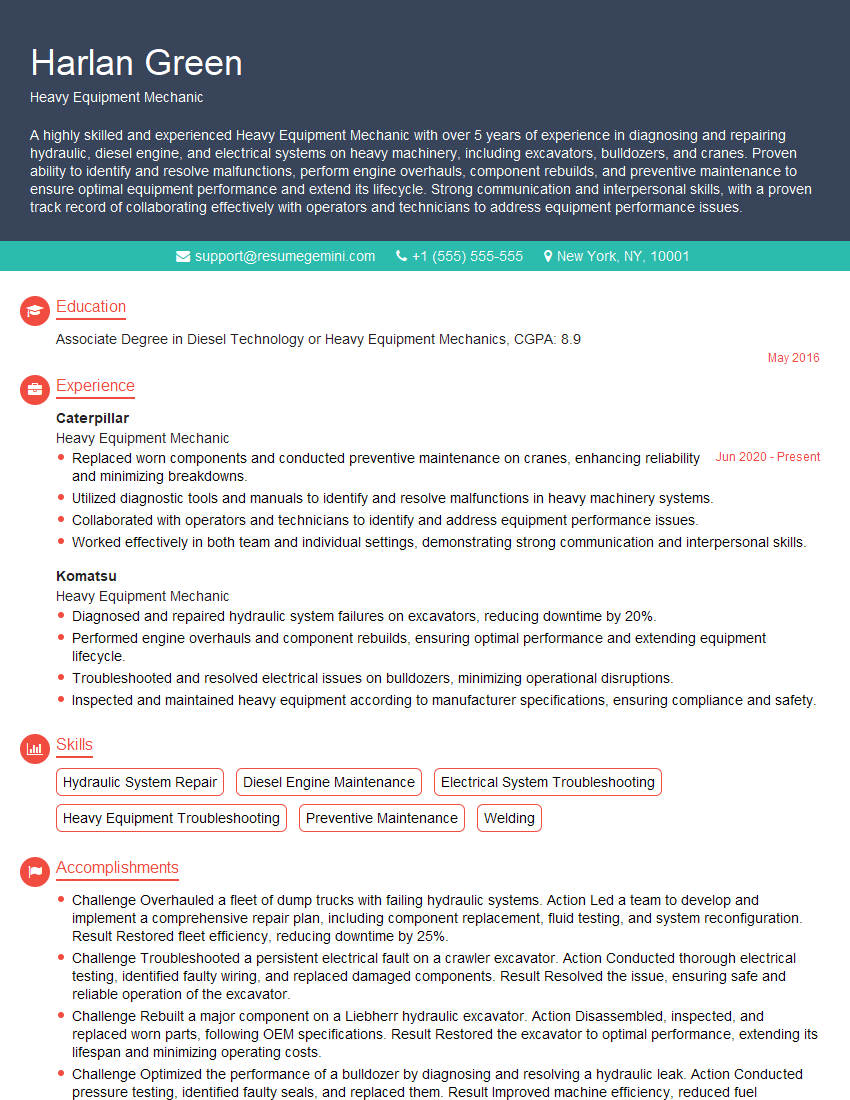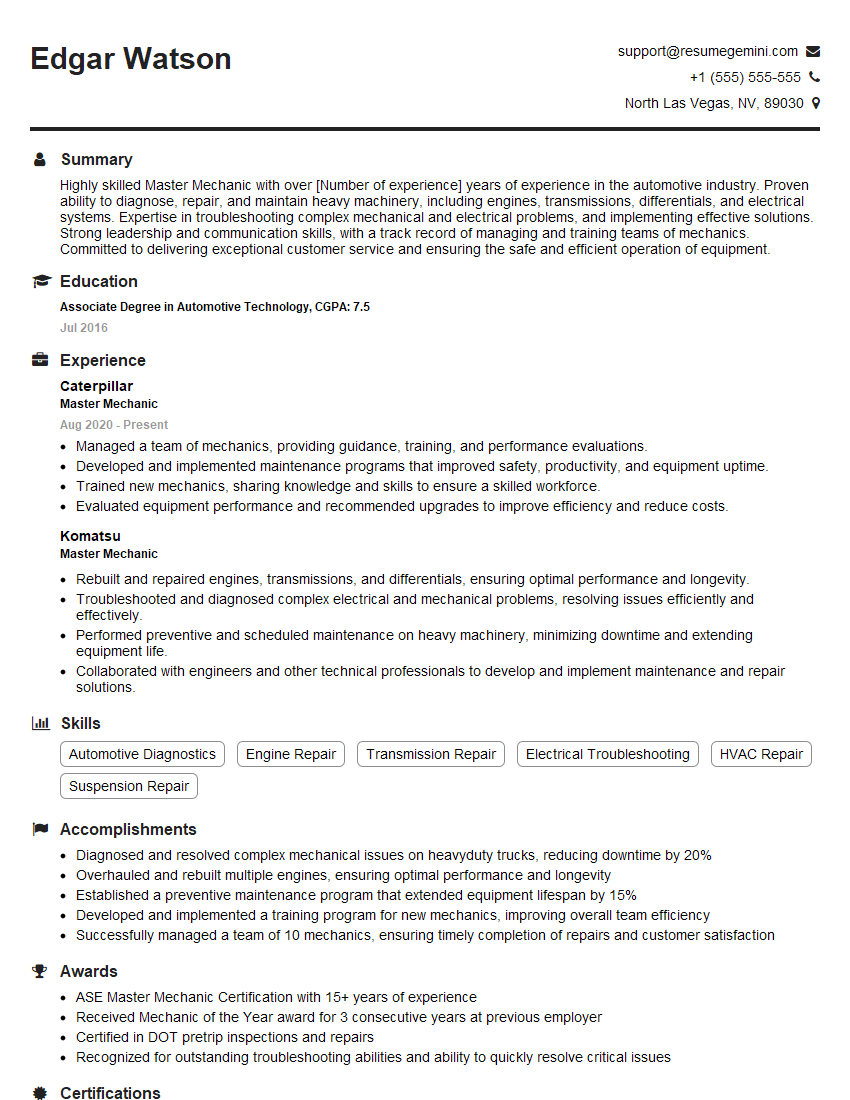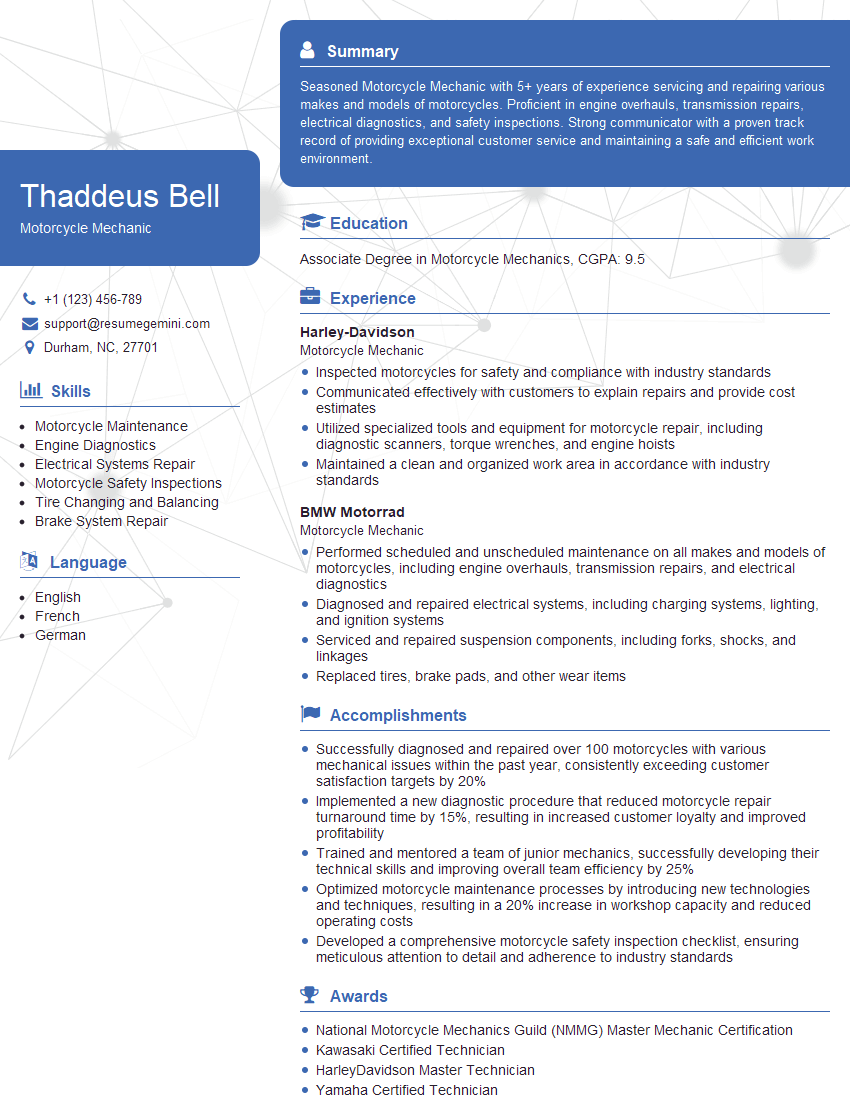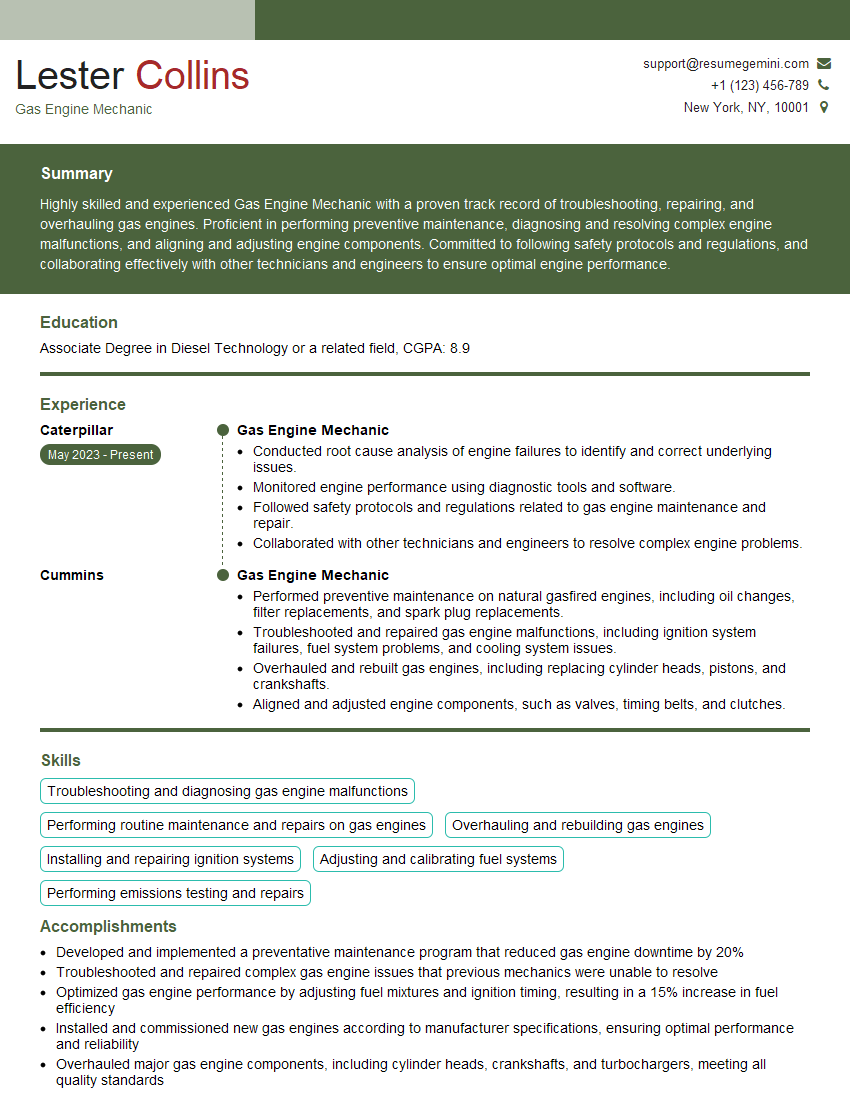Preparation is the key to success in any interview. In this post, we’ll explore crucial Engine repair (basic) interview questions and equip you with strategies to craft impactful answers. Whether you’re a beginner or a pro, these tips will elevate your preparation.
Questions Asked in Engine repair (basic) Interview
Q 1. What are the main components of an internal combustion engine?
An internal combustion engine (ICE) has several key components working together to convert fuel into motion. Think of it like a complex machine with many vital organs. The main components include:
- Cylinder Block: The foundation, housing the cylinders where combustion happens. Imagine it as the engine’s skeleton.
- Cylinders: These are the chambers where the pistons move up and down. Each cylinder is like a small, powerful pump.
- Pistons: These move within the cylinders, driven by the expanding gases from combustion. They’re like the engine’s muscles.
- Connecting Rods: These link the pistons to the crankshaft, transferring the piston’s up-and-down motion into rotational motion. Think of them as the engine’s joints.
- Crankshaft: This converts the linear motion of the pistons into the rotational motion that drives the wheels. This is the engine’s main power output shaft.
- Valves (Intake and Exhaust): These control the flow of air and fuel into the cylinder and the expulsion of exhaust gases. They act like the engine’s breathing system.
- Camshaft: This controls the timing of the valves’ opening and closing. It’s the engine’s timing coordinator.
- Spark Plugs (or Glow Plugs): These ignite the air-fuel mixture in the cylinders (gasoline engines use spark plugs, diesel engines use glow plugs). They’re like the engine’s igniters.
- Carburetor or Fuel Injection System: This delivers the precise amount of fuel to the cylinders. It’s the engine’s fuel supply system.
- Lubrication System: This circulates oil to lubricate moving parts, reducing friction and wear. It’s the engine’s lifeblood.
- Cooling System: This regulates the engine’s temperature to prevent overheating. It’s the engine’s temperature control system.
These components work in a coordinated sequence to produce power. A malfunction in any one part can significantly impact the engine’s performance.
Q 2. Explain the four-stroke cycle.
The four-stroke cycle is the fundamental process by which most internal combustion engines generate power. Each stroke refers to a complete up or down movement of the piston within a cylinder. The four strokes are:
- Intake Stroke: The piston moves down, drawing a mixture of air and fuel into the cylinder. Think of it like inhaling.
- Compression Stroke: The piston moves up, compressing the air-fuel mixture. This increases pressure and temperature, preparing for ignition.
- Power Stroke: The spark plug ignites the compressed mixture, causing a rapid expansion of gases that pushes the piston down. This is where the engine’s power is generated. It’s the exhale of the engine, forceful and powerful.
- Exhaust Stroke: The piston moves up, pushing the spent exhaust gases out of the cylinder. It’s like exhaling the used air.
These four strokes repeat continuously in each cylinder, creating a smooth rotational force from the crankshaft. This is a continuous loop – intake, compress, power, exhaust – that generates engine power.
Q 3. Describe the function of the spark plugs.
Spark plugs are essential for igniting the air-fuel mixture in gasoline engines. They consist of a central electrode surrounded by a ground electrode, separated by a small gap. When a high-voltage electrical current is passed across this gap, it creates a spark that ignites the fuel-air mixture in the combustion chamber. This ignition initiates the power stroke of the four-stroke cycle.
Imagine it as the match that lights the fire in the engine’s cylinder. Without functioning spark plugs, combustion doesn’t occur, and the engine won’t run.
Q 4. What is the role of the carburetor or fuel injection system?
The carburetor or fuel injection system is responsible for delivering the correct amount of fuel to the engine’s cylinders for efficient combustion. Carburetors use air pressure to mix fuel and air, while fuel injection systems use electronically controlled injectors to precisely meter fuel into each cylinder. Both systems ensure the proper fuel-to-air ratio for optimal engine performance and fuel efficiency.
Think of it as the engine’s digestive system, ensuring the correct fuel mix for the ‘burning’ process. A faulty system can lead to poor engine performance, such as stalling or rough running. A well-maintained fuel system is crucial for fuel economy and emissions compliance.
Q 5. How does the cooling system work?
The cooling system maintains the optimal operating temperature of the engine. Overheating can cause significant damage, so it’s crucial for engine longevity. Most systems use a liquid coolant (often a mixture of water and antifreeze) circulated through passages in the engine block and cylinder head. A water pump circulates the coolant, and a radiator dissipates the heat into the atmosphere. A thermostat regulates the coolant flow to maintain a stable temperature.
This is analogous to the human body’s temperature regulation; the cooling system prevents the engine from getting too hot, preventing damage to vital components.
Q 6. What is the purpose of the oil system?
The oil system lubricates all the moving parts within the engine, reducing friction and wear. This is vital for preventing engine damage and ensuring smooth operation. The oil is pumped under pressure to all critical components, including the crankshaft, connecting rods, camshaft, and valve train. An oil filter removes contaminants from the oil, keeping it clean and extending its lifespan.
Think of it like the circulatory system in your body, it delivers the lifeblood (oil) to all parts of the engine to keep it running smoothly. Oil that is dirty, low in volume, or too thick affects the engine’s performance and can result in serious damage.
Q 7. Explain how the ignition system works.
The ignition system provides the high-voltage spark needed to ignite the air-fuel mixture in gasoline engines. This system typically consists of:
- Ignition Coil: This increases the voltage from the battery to a level sufficient to create a spark.
- Distributor (in older systems): This distributes the high-voltage current to the correct spark plug at the appropriate time.
- Spark Plug Wires: These carry the high-voltage current from the coil to the spark plugs.
- Ignition Control Module (ICM) or Electronic Control Unit (ECU): This controls the timing of the spark, ensuring it occurs at the precise moment for optimal combustion.
Modern engines often use electronic ignition systems, which offer better precision and reliability compared to older mechanical systems. A malfunctioning ignition system can prevent the engine from starting or cause misfires, leading to poor performance and potentially engine damage.
Q 8. What are the common causes of engine overheating?
Engine overheating is a serious issue that can lead to significant engine damage. It usually stems from a problem with the cooling system’s ability to dissipate heat generated during combustion.
- Low Coolant Levels: Think of coolant as the engine’s blood; insufficient levels mean poor heat transfer. A leak in the radiator, hoses, or water pump will cause this. I once worked on a car where a tiny pinhole leak in a hose was the culprit – hard to spot, but caused major overheating.
- Faulty Thermostat: The thermostat regulates coolant flow. If it’s stuck closed, coolant can’t circulate effectively, leading to overheating. Conversely, if it’s stuck open, the engine might not reach optimal operating temperature.
- Failing Water Pump: This pump circulates the coolant. If it’s failing, coolant flow is reduced, resulting in heat buildup. A whining noise from the water pump is a classic sign of impending failure.
- Radiator Issues: A clogged radiator (due to debris or corrosion) hinders efficient heat dissipation. A bent or damaged radiator fin can also reduce cooling capacity.
- Fan Problems: The cooling fan draws air across the radiator. If the fan motor is faulty or the fan clutch is malfunctioning, heat won’t be removed effectively.
- Head Gasket Failure: In severe cases, a blown head gasket can allow coolant to leak into the cylinders, leading to catastrophic overheating and potential engine failure. This often presents as white smoke from the exhaust and milky oil.
Diagnosing the exact cause requires careful inspection of all components of the cooling system, often involving pressure testing the system to detect leaks.
Q 9. How do you diagnose a misfire?
A misfire occurs when one or more cylinders fail to ignite properly. This can manifest in various ways, making diagnosis crucial.
- Rough Running Engine: The engine may shake or vibrate excessively, especially at idle or under acceleration. It might feel like it’s missing beats.
- Reduced Power: The car may accelerate sluggishly or hesitate.
- Check Engine Light: The illuminated check engine light usually accompanies a misfire, along with a diagnostic trouble code (DTC) that points to the specific cylinder or system at fault.
- Exhaust Smoke: Excessive black smoke can indicate a rich fuel mixture due to a misfire.
Diagnosing a misfire involves checking several potential sources:
- Spark Plugs: Inspect for wear, fouling, or damage. Worn plugs are a common cause, as are improperly gapped plugs.
- Ignition Coils: Test for proper voltage output. A failing coil will prevent ignition in a specific cylinder.
- Worn Wires: Check ignition wires for cracks or damage that can impede spark delivery.
- Fuel Injectors: Check for proper fuel delivery. A clogged or faulty injector will starve a cylinder of fuel.
- Sensors: Faulty sensors like the crankshaft position sensor (CKP) or camshaft position sensor (CMP) can disrupt ignition timing and cause a misfire.
A scan tool with OBD-II capabilities helps identify which cylinder is misfiring, speeding up the diagnosis. Often, a simple visual inspection and testing of components is enough to pinpoint the problem. I remember a case where a simple loose spark plug wire was causing multiple misfires; a simple fix, but easily overlooked.
Q 10. How do you check engine oil level and condition?
Checking engine oil is a fundamental part of basic engine maintenance. You check both the level and the condition.
Checking the Level:
- Park the vehicle on a level surface. This ensures an accurate reading.
- Wait for the engine to cool down. Hot oil expands, giving a false reading.
- Locate the dipstick. It usually has a handle with markings.
- Remove the dipstick, wipe it clean, and reinsert it fully.
- Remove the dipstick again and check the oil level against the markings. The level should be between the minimum and maximum lines. Low oil levels indicate potential leaks or consumption.
Checking the Condition:
- Examine the oil on the dipstick. The oil should be relatively clear and amber in color. Dark brown or black oil indicates it’s time for an oil change.
- Check for contaminants. Milky or foamy oil might indicate coolant contamination (head gasket failure). Metallic particles suggest internal engine damage.
- Smell the oil. A strong burning smell can point to a problem.
Regularly checking your engine oil, and performing timely oil changes, helps prevent costly engine damage. Many times, I’ve seen neglected oil leading to significant wear and tear, even catastrophic engine failure.
Q 11. What are the signs of a worn timing belt?
A worn timing belt is a serious issue that can lead to catastrophic engine damage if it breaks. Regular inspection is vital.
- Cracks or Frayed Edges: Visible cracking or fraying on the belt surface is a clear sign of wear. It resembles wear and tear on a rubber band.
- Missing Teeth: If you see missing or damaged teeth on the belt, it needs immediate replacement.
- Hardening or Stiffness: A stiff or hardened belt doesn’t flex correctly, potentially causing uneven tension and premature wear.
- Excessive Wear on the Teeth: Unusual wear patterns or significantly worn teeth, especially at the edges, indicate it’s reaching the end of its life.
- Unusual Noises: Squealing, chirping, or clicking sounds from the timing belt area can suggest wear and tear or slippage.
Note that timing belts are often made of rubber and are subject to degradation over time. It is always better to replace a timing belt according to the manufacturer’s recommended schedule, to prevent any expensive damage.
Q 12. How do you check the condition of spark plugs?
Spark plugs are essential for ignition; their condition directly impacts engine performance. Inspection is straightforward:
- Remove the spark plug from the cylinder using a spark plug socket.
- Visually inspect the insulator. A clean, light tan or grayish insulator is ideal. Dark brown or black indicates a rich fuel mixture (possibly due to a faulty sensor or injector). White indicates a lean fuel mixture (possibly due to a restricted air intake).
- Examine the electrodes. Excessive wear or erosion on the electrodes reduces the spark’s effectiveness. Rounded or heavily worn electrodes need replacement.
- Check for fouling. Oil or carbon buildup on the insulator or electrodes indicates problems with the engine’s combustion process, valve seals or piston rings.
- Check the gap. The gap between the electrodes should match the manufacturer’s specifications. An incorrect gap impairs ignition.
Always use the correct type of spark plug and gap for your engine. Using the wrong type will lead to premature wear and potential misfires. A simple visual inspection can be very helpful in identifying problems before they cause bigger problems.
Q 13. What are the symptoms of a bad fuel pump?
A failing fuel pump is a common problem that can significantly impact engine performance.
- Difficulty Starting: The engine cranks but struggles to start, especially when the fuel tank is low.
- Loss of Power: Sudden loss of power or hesitation during acceleration, especially under load.
- Engine Stalling: The engine may stall unexpectedly, especially after prolonged periods of running.
- Fuel Pressure Issues: Low fuel pressure, measured with a fuel pressure gauge, is a definitive sign of a failing fuel pump.
- Whining Noise: Sometimes, you might hear a whining or buzzing noise coming from the fuel tank area, indicative of a failing pump.
Diagnosing a bad fuel pump requires checking fuel pressure, listening for unusual noises, and potentially examining the fuel pump itself (if accessible). It’s often easier to replace the entire fuel pump assembly rather than just the pump itself. I recall one situation where a customer initially complained of rough running. After several tests, we discovered a weak fuel pump was preventing consistent fuel delivery, causing the problem. A simple fuel pump replacement solved the issue.
Q 14. How do you check the air filter?
The air filter is a crucial component that prevents dust and debris from entering the engine. Regular checks are important.
- Locate the air filter housing. It’s usually a plastic box connected to the intake system.
- Open the housing and remove the air filter.
- Inspect the filter for dirt and debris. A clean filter will be relatively white or light gray. A dirty filter will be dark gray, brown, or even black.
- Check for tears or damage. If there are tears or holes, the filter needs replacement.
- Hold the filter up to a light. If light passes through easily, the filter is likely clogged and needs to be replaced.
A dirty air filter restricts airflow, leading to reduced engine performance, poor fuel economy, and potentially damaging engine components. A clogged air filter is one of the easiest things to check, yet many people overlook it. Regular replacement is essential, and it’s a low-cost, high-impact maintenance task.
Q 15. Explain the function of the alternator.
The alternator is essentially your car’s power generator. It’s a crucial component that converts mechanical energy from the engine’s rotation into electrical energy. This electrical energy charges the battery and powers all the electrical systems in your vehicle while the engine is running. Think of it like a small power plant inside your car, keeping everything running smoothly.
Without a functioning alternator, your battery would quickly drain, leaving you stranded. Once the engine is turned off, the battery powers everything, but once it’s depleted, the vehicle’s electrical systems fail. The alternator prevents this from happening by continuously replenishing the battery’s charge.
Career Expert Tips:
- Ace those interviews! Prepare effectively by reviewing the Top 50 Most Common Interview Questions on ResumeGemini.
- Navigate your job search with confidence! Explore a wide range of Career Tips on ResumeGemini. Learn about common challenges and recommendations to overcome them.
- Craft the perfect resume! Master the Art of Resume Writing with ResumeGemini’s guide. Showcase your unique qualifications and achievements effectively.
- Don’t miss out on holiday savings! Build your dream resume with ResumeGemini’s ATS optimized templates.
Q 16. How do you jump-start a car?
Jump-starting a car involves using a fully charged battery from another vehicle to provide enough power to start a car with a dead battery. It’s important to follow safety precautions meticulously.
- Ensure safety: Engage parking brakes on both vehicles, turn off all accessories, and ensure both vehicles are in a well-ventilated area away from flammable materials.
- Connect the cables: Connect the red (positive) clamp to the positive (+) terminal of the dead battery first, then to the positive (+) terminal of the good battery. Next, connect the black (negative) clamp to the negative (-) terminal of the good battery, and finally to an unpainted metal surface on the engine block of the dead battery (avoiding the battery terminal itself to prevent sparks near the battery).
- Start the running vehicle: Let the running vehicle charge the dead battery for a few minutes, then attempt to start the vehicle with the dead battery.
- Disconnect the cables: Disconnect the cables in reverse order – from the engine block, then from the negative terminal of the good battery, then from the positive terminal of the dead battery, and finally from the positive terminal of the good battery.
Improper jump-starting can lead to sparks, explosions, or damage to electrical systems, so always exercise caution.
Q 17. What safety precautions should be taken when working on an engine?
Safety is paramount when working on an engine. Never compromise on safety procedures, even for seemingly minor tasks. Here’s a list of essential precautions:
- Always disconnect the battery: This prevents accidental short circuits that can lead to injury or damage.
- Use jack stands: Never rely solely on a jack to support the vehicle. Always use jack stands for added safety.
- Wear appropriate safety gear: Eye protection, gloves, and closed-toe shoes are mandatory. A respirator might be necessary depending on the tasks.
- Work in a well-ventilated area: Engine compartments contain fumes and can be hazardous. Proper ventilation is crucial to prevent exposure.
- Use proper tools: Avoid using damaged or inappropriate tools; this is essential for your safety and to prevent damage to the engine.
- Never work alone: Always have someone nearby in case of an emergency.
Q 18. How do you properly dispose of used motor oil?
Used motor oil is a hazardous waste and should never be disposed of improperly. Pouring it down the drain or onto the ground contaminates water sources and the environment. Always take it to a designated collection center. Many auto parts stores and recycling centers accept used motor oil free of charge. Alternatively, check with your local municipality for authorized disposal locations. You can even find some oil recycling bins at car washes.
Some municipalities have specific programs for handling used motor oil, so always check your local guidelines to ensure you’re following regulations. It’s a small effort that makes a big difference in environmental protection.
Q 19. What is the difference between a gasoline and diesel engine?
Gasoline and diesel engines are both internal combustion engines, meaning they burn fuel to create power, but they differ significantly in their design and operation.
- Fuel: Gasoline engines use gasoline, a volatile fuel that ignites easily with a spark plug. Diesel engines use diesel fuel, which ignites through compression.
- Ignition: Gasoline engines use spark plugs to ignite the air-fuel mixture, whereas diesel engines rely on the heat generated by compressing the air to ignite the fuel.
- Compression ratio: Diesel engines have a much higher compression ratio than gasoline engines, leading to higher efficiency but also requiring more robust engine construction.
- Emissions: Diesel engines historically produce more particulate matter but advancements in technology are reducing these emissions. Gasoline engines tend to produce more greenhouse gases.
In simpler terms, think of it like this: a gasoline engine is like a quick, spark-driven explosion, while a diesel engine is a more controlled, pressure-driven burn.
Q 20. What tools are essential for basic engine repair?
A basic engine repair toolkit should include:
- Socket wrench set (metric and standard)
- Wrenches (various sizes)
- Screwdrivers (Phillips and flathead)
- Pliers (needle-nose and slip-joint)
- Ratchet and extensions
- Torque wrench
- Jack stands and a jack
- Wheel chocks
- Gloves and safety glasses
- Drain pan
Beyond these essentials, specialized tools may be needed depending on the specific repair.
Q 21. Describe your experience with engine diagnostics.
My experience with engine diagnostics includes troubleshooting a wide range of issues using various diagnostic tools, including code readers and multimeters. For example, I recently diagnosed a misfire in a customer’s vehicle by using a code reader to identify the affected cylinder and then using a multimeter to test the spark plug and ignition coil. The fault was eventually traced to a bad coil pack. Another example was diagnosing a no-start issue which was caused by a faulty crankshaft sensor. I can identify issues like low compression, vacuum leaks, and faulty sensors. I’m proficient in interpreting diagnostic trouble codes (DTCs) and correlating them with potential mechanical issues. My approach to diagnostics is systematic, beginning with a thorough visual inspection and moving toward more specialized tools as necessary.
Q 22. Explain your experience with different types of engine components.
My experience encompasses a wide range of engine components, from the basic to more complex systems. I’m proficient in working with internal combustion engine parts like the cylinder head, cylinder block, pistons, connecting rods, crankshaft, camshaft, valves, and their associated components like valve springs, lifters, and timing chains or belts. I also have hands-on experience with the intake and exhaust manifolds, carburetors (or throttle bodies in fuel-injected engines), fuel pumps, ignition systems (distributor, ignition coil, spark plugs), and cooling systems (radiator, water pump, thermostat). Understanding how these parts interact is crucial for effective diagnostics and repair.
- Example 1: I’ve rebuilt numerous cylinder heads, carefully inspecting for cracks, valve guide wear, and ensuring proper valve seating. This requires precision and attention to detail.
- Example 2: I’ve troubleshooted numerous ignition system issues, using a multimeter and diagnostic tools to pinpoint faulty components, ranging from a bad coil to a failing crankshaft position sensor. This often involved understanding electrical circuits and how they affect engine performance.
Q 23. How do you troubleshoot a starting problem?
Troubleshooting a starting problem is a systematic process of elimination. I start by checking the obvious: battery voltage and connections. A low voltage or corroded terminals can easily prevent the engine from cranking. Then, I move on to the starter motor itself; a clicking sound often indicates a low battery or a faulty starter solenoid. Next, I examine the ignition system: Is fuel being delivered? Is there spark at the spark plugs? I’ll use a spark tester to verify this. If the engine cranks but doesn’t start, it’s likely a fuel delivery issue or a problem with the engine’s internal components (compression issues, etc.). A diagnostic scanner can help identify underlying issues.
Think of it like this: a car starting is like a chain reaction; each link must function correctly. A weak battery (link 1) prevents the starter (link 2) from working, and no spark (link 3) means no combustion (link 4). Each link needs to be checked.
Q 24. How do you interpret a vehicle’s diagnostic trouble codes (DTCs)?
Diagnostic Trouble Codes (DTCs) are numerical codes stored by the vehicle’s onboard computer (ECU) when a problem is detected. These codes offer valuable clues to the problem’s location. I use a scan tool to retrieve these codes. Each code corresponds to a specific issue, detailed in a repair manual or online database. For instance, a code like P0171 might indicate a system too lean (Bank 1), which could point towards a problem with the air/fuel mixture, possibly a vacuum leak or a malfunctioning oxygen sensor. It’s not just about reading the code; it’s about interpreting it in the context of the vehicle’s symptoms to diagnose the root cause.
Q 25. What is your experience with engine repair manuals and diagrams?
Engine repair manuals and diagrams are indispensable tools. I regularly consult them for detailed specifications, component locations, torque values, and wiring diagrams. They provide step-by-step instructions for repairs and troubleshooting. I find that visual aids, like diagrams, are particularly helpful in understanding the complex interplay of engine components. I’m proficient with both factory service manuals and aftermarket resources, understanding their strengths and limitations.
For example, recently I used a Haynes manual to troubleshoot a tricky issue on a fuel injection system; the detailed wiring diagrams within proved invaluable in tracing the electrical circuit and locating a short.
Q 26. Describe a time you had to troubleshoot a complex engine problem.
I once encountered a situation where a vehicle had a misfire that was intermittent and difficult to diagnose. Initial scans revealed multiple random misfire codes, which pointed towards numerous potential causes. I began systematically checking ignition components (spark plugs, wires, coil packs) and fuel delivery systems. After several tests, I discovered a very subtle crack in one of the intake manifold runners. This crack only appeared under high engine load, explaining why the misfire was intermittent. The problem was easily overlooked, but through a careful process of elimination, utilizing diagnostic tools and my understanding of engine mechanics, I was able to solve the issue.
Q 27. How do you maintain your tools and equipment?
Maintaining my tools and equipment is a top priority. This ensures both safety and accuracy. After every job, I clean my tools thoroughly, removing any debris or oil. I regularly inspect them for damage and sharpen any cutting tools as needed. More complex equipment like diagnostic scanners requires regular software updates to ensure they are functioning optimally and have access to the latest DTC information. Storage is also key; keeping tools organized and protected from the elements helps prolong their lifespan.
Q 28. What are your strengths and weaknesses as a mechanic?
My strengths lie in my systematic approach to troubleshooting, my attention to detail, and my ability to quickly learn and adapt to new challenges. I’m comfortable working independently and as part of a team. I’m also a strong advocate for continuous learning, staying updated on the latest automotive technologies and repair techniques.
A weakness I’m working on is time management, especially when faced with multiple urgent tasks. I’m actively developing strategies to prioritize and efficiently manage my workload to ensure timely completion of repairs.
Key Topics to Learn for Engine Repair (Basic) Interview
- Engine Components & Functions: Understanding the role of each major engine component (e.g., pistons, cylinders, crankshaft, valves) and how they work together to produce power.
- Basic Engine Diagnostics: Learning to identify common engine problems through visual inspection, listening for unusual sounds, and using basic diagnostic tools.
- Lubrication Systems: Understanding the importance of engine oil, its function, and how to check oil levels and identify potential oil leaks.
- Cooling Systems: Knowing how the cooling system works, common cooling system problems (e.g., leaks, overheating), and how to address them.
- Ignition Systems (Spark Plugs & Ignition Coils): Understanding how the ignition system works and troubleshooting common ignition issues.
- Fuel Systems (Carburetors or Fuel Injection): Gaining a basic understanding of how fuel is delivered to the engine and common fuel system problems.
- Basic Maintenance Procedures: Familiarizing yourself with routine maintenance tasks like oil changes, filter replacements, and spark plug replacements.
- Safety Procedures: Understanding and emphasizing the importance of safety precautions when working on engines, including proper use of tools and personal protective equipment (PPE).
- Troubleshooting and Problem-Solving: Developing a systematic approach to diagnosing and repairing engine problems, focusing on logical deduction and methodical checks.
- Common Engine Repairs: Gaining practical experience with minor engine repairs, such as replacing spark plugs, hoses, belts, and other easily accessible parts.
Next Steps
Mastering basic engine repair opens doors to a rewarding career with excellent growth potential. A strong foundation in these skills makes you a valuable asset to any automotive repair team. To significantly boost your job prospects, create an ATS-friendly resume that highlights your skills and experience effectively. ResumeGemini is a trusted resource to help you build a professional and impactful resume. We offer examples of resumes tailored to entry-level engine repair positions to help you get started. Invest the time in crafting a strong resume—it’s your first impression on potential employers.
Explore more articles
Users Rating of Our Blogs
Share Your Experience
We value your feedback! Please rate our content and share your thoughts (optional).
What Readers Say About Our Blog
Hi, I’m Jay, we have a few potential clients that are interested in your services, thought you might be a good fit. I’d love to talk about the details, when do you have time to talk?
Best,
Jay
Founder | CEO

